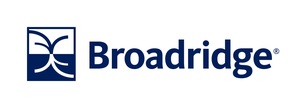LAKE SUCCESS, N.Y., July 28, 2016 /PRNewswire/ -- Independent broker dealers (IBDs) and wirehouse firms experienced net asset outflows of two percent for actively managed mutual funds in the first half of 2016, according to data released today by Broadridge Financial Solutions, Inc. (NYSE:BR) via its Fund Distribution Intelligence. Much of the outflows of actively managed funds from broker dealers appeared to move to passively managed mutual funds and ETFs. During the first half of 2016, net new assets for passively managed funds and ETFs increased by nine percent and one percent for IBDs and wirehouses, respectively.
"During the first half of 2016, net new assets for passively managed mutual funds increased by $37 billion, or 14 percent, for the retail distribution channels, while actively managed funds were down by $24 billion, or 0.6 percent," said Frank Polefrone, senior vice president of Broadridge's data and analytics business. "With pending regulatory changes related to appropriate share class usage and the Department of Labor's new fiduciary rule, we expect the growing use of passively managed funds by advisors, along with the increasing popularity of ETFs to continue to accelerate."
The bulk of the $35 billion of net outflows from actively managed mutual fund accounts held at IBDs moved to ETFs, which recorded an increase of net new assets of $34.9 billion. The shift to passive ETF products by IBDs increased the overall share of passive products from 19.5 percent at the end of 2015 to 21 percent of total fund and ETF assets managed by IBDs. The wirehouse channel experienced net outflows of $21 billion from actively managed funds, but only increased assets of passively managed funds and ETFs by $5.2 billion. As a result, wirehouses experienced net outflows of long-term funds and ETFs of $13 billion in the first half of 2016, and lost overall market share to other retail channels.
The shift from active management to passive products for other retail channels was not as pronounced during the first half of 2016, primarily because these channels already have a larger portion of fund and ETF assets invested in passive products. The registered investment advisor (RIA) channel, which has 33 percent of its assets in passively managed products experienced virtually no change in total mutual fund assets in the first half of 2016, while ETF net new assets increased by 2.4 percent during the same period. The discount channel, which is dominated by Vanguard and Schwab discount brokerage operations, was up significantly in both net mutual fund and ETF assets. The channel has 55 percent of assets held in passively managed funds and ETFs.
In the first half of 2016, overall net new assets for ETFs increased by 1.2 percent to $2.2 trillion. Of the $24.8 billion of net new assets, $22.5 billion, or 91 percent of the increase, came from passively managed ETFs. Net new flows for long-term mutual funds showed a similar pattern, with net new assets also increasing by 1.2 percent to $7.4 trillion of assets from third party financial intermediaries. Of the $84.7 billion of net new long-term mutual fund assets, $30.6 billion, or 36 percent of the increase, came from passively managed mutual funds.
Additional key findings include:
- Net new assets of ETFs for retail channels – RIA, IBD, wirehouse and discount B/D – were up by $61.3 billion in the second quarter, while net new assets for institutional channels – private bank, bank and trust – were down by $30.4 billion.
- Net new assets for retail long-term funds were up by $12.8 billion, while institutional long-term fund net flows increased by $71.7 billion.
- Net new assets of passive products for the retail channels increased across major US product categories - US large cap (+13 percent), US mid cap (+11.6 percent), and US fixed income (+20 percent).
- Net new assets of active products for the retail channels decreased for US large cap (-2.7 percent), US mid cap (-6.7 percent), US small cap (-0.4 percent) and increased for US fixed income (+5.7 percent), high yield income (+4.8 percent) and US municipal (+11.7 percent).
Broadridge's Fund Distribution Intelligence comprises the most complete sales and asset data collection in the industry, creating transparency into more than $9 trillion of long-term mutual fund and ETF assets across a majority of mutual fund distributors.
About Broadridge
Broadridge Financial Solutions, Inc. (NYSE:BR) is the leading provider of investor communications and technology-driven solutions for broker-dealers, banks, mutual funds and corporate issuers globally. Broadridge's investor communications, securities processing and managed services solutions help clients reduce their capital investments in operations infrastructure, allowing them to increase their focus on core business activities. With over 50 years of experience, Broadridge's infrastructure underpins proxy voting services for over 90 percent of public companies and mutual funds in North America, and processes on average $5 trillion in fixed income and equity trades per day. Broadridge employs more than 9,000 full-time associates in 14 countries.
For more information about Broadridge, please visit www.broadridge.com.
| Media Contacts: |
|
| Linda Namias |
Maggie Nolan |
| Broadridge Financial Solutions |
Brainerd Communicators, Inc. |
| +1 631-254-7711 |
+1 212-986-6667 |
Photo - http://photos.prnewswire.com/prnh/20160728/393729-INFO
Logo - http://photos.prnewswire.com/prnh/20110920/MM71626LOGO
SOURCE Broadridge Financial Solutions, Inc.
Related Links
WANT YOUR COMPANY'S NEWS FEATURED ON PRNEWSWIRE.COM?
Newsrooms &
Influencers
Digital Media
Outlets
Journalists
Opted In





Share this article